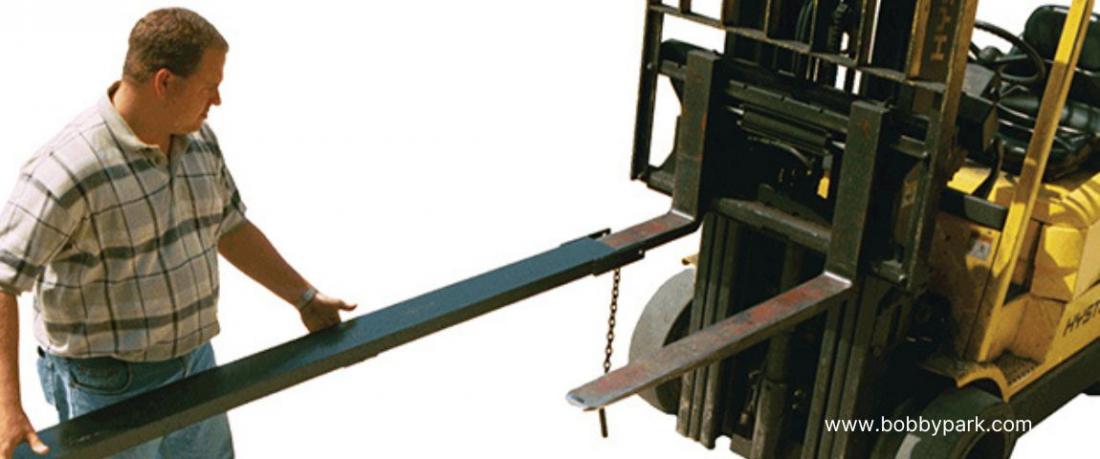HOW TO MAKE FORKLIFT EXTENSIONS? GETTING PROFESSIONAL HELP

In material handling, forklifts are crucial in efficiently moving heavy loads. However, there are instances when the standard forks on a forklift aren't long enough to handle particularly large or oddly shaped items. This is where forklift extensions DIY come into play. This article by our Bobby Park Truck and Equipment expert will delve into forklift extensions, emphasizing the importance of seeking professional assistance for optimal results.
Understanding Forklift Extensions DIY
DIY understanding of forklift extensions is essential for those looking to customize their equipment. This involves comprehending the intricacies of measurements, materials, and welding techniques. With the right knowledge, enthusiasts can craft extensions tailored to their load-handling needs.
What Are Forklift Extensions?
Forklift extensions, also known as fork extensions or tines, are supplemental attachments that fit onto the existing forks of a forklift. They extend the reach of the forks, allowing for the safe handling of longer or larger loads.
When Are Forklift Extensions Necessary?
Forklift extensions become necessary when standard forks cannot adequately support or stabilize a load. Adequately common when dealing with items like pipes or large crates.
Cost Considerations
When considering the costs of DIY forklift extensions, weighing initial expenses against potential long-term savings is crucial. While a DIY approach may seem cost-effective initially, professional fabrication from used forklifts and truck dealers often leads to greater durability, reduced maintenance, and enhanced safety, ultimately proving a wise investment.
Maintenance and Care
Choosing well-maintained forklift trucks ensures their longevity and safety. Regularly inspect for signs of wear, misalignment, or damage. Promptly address any issues and consult a professional truck dealership company for repairs or modifications to ensure optimal performance.
Safety Precautions Explained by Used Trucks Dealer
Prioritizing safety in forklift extension fabrication is paramount. This section outlines crucial precautions to ensure a secure working environment. From personal protective equipment (PPE) requirements to understanding potential hazards, adhering to safety measures is fundamental in this process.
Prioritizing Safety: Why It Matters?
Forklift safety measures should always be the top priority when working with heavy machinery. It safeguards the operator and the equipment, preventing accidents and potential damage. Complying with safety measures ensures a secure working environment and promotes efficiency in material handling operations.
Personal Protective Equipment (PPE) Requirements
Before installing DIY extensions, ensure all workers have the necessary PPE or personal protection equipment. This includes safety goggles, gloves, and steel-toed boots to prevent potential hazards.
Materials and Tools Needed for DIY Forklift Extensions
The right materials and tools are the backbone of any successful forklift extension project. This section provides an overview of the essential components required, including high-quality steel, welding materials, and specialized equipment. Forklift dealers, including Bobby Park Truck and Equipment, will help you understand and gather the elements crucial for a smooth fabrication process.
Essential Materials
-
High-quality steel for durability
-
Welding materials
-
Reinforcement components
Tools of the Trade
-
Tape measure and marking tools
-
Cutting equipment (plasma cutter or saw)
-
Welding machine and protective gear
-
Grinders for finishing
Step-by-Step Guide to Making Forklift Extensions
The step-by-step guide will enlighten the clients with the crafting forklift extensions. Each stage is critical for a secure and functional extension, from precise measurements to skilled welding. Following these instructions ensures a successful fabrication, guaranteeing enhanced forklift capabilities.
Measuring and Marking
Accurate measurements are crucial. Mark the steel with precision to ensure proper fit.
Cutting the Steel
Carefully cut the steel to the required length using the appropriate cutting tool.
Welding the Extension
Skillfully weld the extension onto the fork, ensuring a strong and secure connection.
Reinforcement for Strength
Strengthen critical points to guarantee the extension can handle heavy loads.
Quality Checks
Thoroughly inspect the extension for any imperfections or weak points before use.
Seeking Professional Assistance
Seeking professional assistance via a used commercial truck dealership for DIY forklift extensions is vital due to the expertise and precision they bring. Professionals possess the necessary equipment and knowledge to ensure safe and effective extensions, reducing the risk of accidents and ensuring compliance with industry standards. Their involvement guarantees a reliable and durable end product.
When handling heavy materials, forklift extensions are invaluable tools. If you are doing forklift extensions DIY, precision and safety are paramount. By following this guide and considering professional assistance, you can ensure that your forklift extensions are effective and safe. Business owners can visit our website to learn more about forklift extensions.
Frequently Asked Questions
Q1: Can I make forklift extensions without professional help?
While forklift extensions DIY seems possible, seeking professional assistance ensures safety and compliance with industry standards.
Q2: Are there specific regulations for forklift extensions?
Various safety and industry standards must be adhered to during making.
Q3: How often should I inspect my forklift extensions?
Regular inspections, ideally before each use, are recommended to identify potential issues.
Q4: Are there different types of forklift extensions for specific loads?
Extensions can be customized to suit different load types and sizes for optimal performance.
WHY CHOOSE US?
- Full Parts and Service Shop
- State of the Art Paint Shop
- Body Work
- Van bodies, reefer bodies, Flatbed bodies and Storage Containers available
- Tuscaloosa and Jackson Locations
- Ships anywhere in the United States

